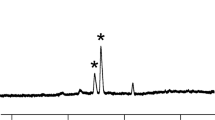Abstract
Heteropteran insects often protect themselves from predators with noxious or toxic compounds, especially when these insects occur in aggregations. The predators of heteropteran insects change from small insect predators to large avian predators over time. Thus, a chemical that is deterrent to one type of predator at one point in time may not be deterrent to another type of predator at another point in time. Additionally, these predator deterrent compounds may be used for other functions such as alarm signaling to other conspecifics. Defensive secretion compounds from the adult and the nymph giant mesquite bug (Thasus neocalifornicus: Coreidae) were isolated and identified by gas chromatography–mass spectrometry and NMR. The predominant compounds isolated from the nymph mesquite bugs during a simulated predator encounter were (E)-2-hexenal and 4-oxo-(E)-2-hexenal. In adults, the major compounds released during a simulated predator encounter were hexyl acetate, hexanal, and hexanol. Results from predator bioassays suggest the nymph compounds are more effective at deterring an insect predator than the adult compounds. By using behavioral bioassays, we determined the role of each individual compound in signaling to other mesquite bugs. The presence of the nymph secretion near a usually compact nymph aggregation caused nymph mesquite bugs to disperse but did not affect adults. Conversely, the presence of the adult secretion caused the usually loose adult aggregation to disperse, but it did not affect nymph aggregation. The compounds that elicited nymph behavioral responses were (E)-2-hexenal and 4-oxo-(E)-2-hexenal, while those that elicited adult behavioral responses were hexyl acetate and hexanal. The differences between the chemical composition of nymph and adult defensive secretions and alarm behavior are possibly due to differences in predator guilds.




Similar content being viewed by others
References
Aldrich, J. R. 1988. Chemical ecology of the Heteroptera. Annu. Rev. Entomol. 33:211–238.
Aldrich, J. R., and Blum, M. S. 1978. Aposematic aggregation of a bug (Hemiptera: Coreidae): The defensive display and formation of aggregations. Biotropica 10:58–61.
Aldrich, J. R., and Yonke, T. R. 1975. Natural products of abdominal and metathoracic scent glands of Coreid bugs. Ann. Entomol. Soc. 68:955–960.
Blum, M. S. 1981. Chemical Defenses of Arthropods. p. 562. Academic, New York.
Brailovsky, H., Schaefer, C. W., Barrera, E., and Packauskas, R. J. 1994. A revision of the genus Thasus (Hemiptera: Coreidae: Coreinae: Nematopodini). J. New York Entomol. Soc. 102:318–343.
Calam, D. H., and Youdeowei, A. 1968. Identification and functions of secretion from the posterior scent gland of fifth instar larva of the bug Dysdercus intermedius. J. Insect Physiol. 14:1147–1158.
De La Torre-Bueno, R. T., and Ambrose, W. G. 1936. Effects of the protective vapors of the Coreid bug Thasus gigas on a tarantula (Eurypelma sp.). Bull. Brook. Entomol. Soc 31:184.
Eisner, T. 1970. Chemical defense against predation in arthropods, pp. 157–217, in E. Sondheimer, and J. B. Simeone (eds.). Chemical EcologyAcademic, New York.
Eisner, T., Eisner, M., and Siegler, M. 2007. Secret weapons: Defenses of insects, spiders, scorpions, and other many-legged creatures. Belknap, Harvard University, Boston, MA.
Forbes, G., and Schaefer, C. W. 2003. Further notes on the genus Thasus (Hemiptera: Heteroptera: Coreidae). J. New York Entomol. Soc. 111:235–241.
Gamberale, G., and Tullberg, B. S. 1998. Apsosematism and gregariousness: the combined effect of group size and coloration on signal repellence. Proc. Roy. Soc. B. 265:889–894.
Kasai, H., Maekawa, M., Kawai, K., Hachisuka, K., Takahasi, Y., Nakamura, H., Sawa, R., Matsui, S., and Matsuda, T. 2005. 4-Oxo-2-hexenal, a mutagen formed by 3-fat peroxidation, causes DNA adduct formation in mouse organs. Indust. Health 43:699–701.
Leal, W. S., Panizzi, A. R., and Niva, C. C. 1994. Alarm pheromone system of leaf-footed bug Leptolossus zonatus (Heteroptera: Coreidae). J. Chem. Ecol. 20:1209–1215.
Miilar, J. G. 2005. Pheromones of true bugs. Topics Curr. Chem. 240:37–84.
Moreira, J. A., and Millar, J. G. 2005. Short and simple synthesis of 4-oxo-(E)-2-hexenal and homologs: Pheromone components and defensive compounds of Hemiptera. J. Chem. Ecol 31:965–968.
Olsen, C. E. 2004. 50 Common Insects of the Southwest. Western National Parks Association, Tucson, AZ.
Prestwich, G. D. 1976. Composition of the scents of eight east African Hemipterans. Nymph–adult chemical polymorphism in Coreids. Ann. Entomol. Soc. 69:812–814.
Sas Institute Inc. 2002. JMP-In Statistical Exploration Software. Version 5. Cary, NC.
Sillén-Tullberg, B. 1988. Evolution of gregariousness in aposematic butterfly larvae: a phylogenetic analysis. Evolution 42:293–305.
Sillén-Tullberg, B. 1993. The effect of biased inclusion of taxa on the correlation between discrete characters in phylogenetic trees. Evolution 47:1182–1191.
Tullberg, B. S., and Hunter, A. F. 1995. Evolution of larval gregariousness in relation to repellent defenses and warning coloration in tree-feeding Macrolepidoptera: a phylogenetic analysis based on independent contrasts. Biol. J. Linn. Soc. 57:253–276.
Acknowledgments
We thank Gabriela and Larry Venable for insect-collecting assistance, Carl Olson for insect-identification assistance, Neil Jacobsen for acquiring the NMR spectra, and Alex Wild for mesquite bug photos. This work was funded by the Beckman Young Investigator Award in Chemical Ecology and an NSF Career Award to J.X.B.
Author information
Authors and Affiliations
Corresponding author
Rights and permissions
About this article
Cite this article
Prudic, K.L., Noge, K. & Becerra, J.X. Adults and Nymphs Do Not Smell the Same: The Different Defensive Compounds of the Giant Mesquite Bug (Thasus neocalifornicus: Coreidae). J Chem Ecol 34, 734–741 (2008). https://doi.org/10.1007/s10886-008-9480-9
Received:
Revised:
Accepted:
Published:
Issue Date:
DOI: https://doi.org/10.1007/s10886-008-9480-9




